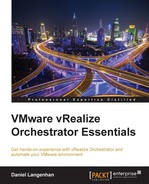This is the second book that I have written on the subject of vRealize Orchestrator, the first being the vRealize Orchestrator Cookbook. The cookbook covers a lot of ground and is pretty full on. So we came to the conclusion to write a book that covers more of the essentials of Orchestrator and helps novices get an easy start.
This book focuses on the basic skills that you need to learn to use Orchestrator. When you've worked through it, you will know enough to create workflows and use them productively as well as share them with the rest of the community. In this book, I tried to keep the focus on the essential skills, and I will explain about backgrounds as much as possible. The book can be regarded as a training class where we build up our skills from one chapter to the next. We will develop a new workflow and then constantly improve it to understand and implement new topics.
Please note that VMware vRealize Orchestrator was renamed from vCenter Orchestrator in late 2014 and is not a new product. In this book, we will just use the name Orchestrator.
This book has been written with vRealize Orchestrator 6.02, but almost everything discussed in this book is applicable to the older versions as well. The following table gives you an overview of what won't work in which version:
|
vCenter Orchestrator (vCO) |
4.x |
No Web Client integration No REST |
|
5.1.x |
No debug mode General improvements in usage | |
|
5.5.x |
General improvements in usage vCO Appliance Cluster support | |
|
vRealize Orchestrator (vRO) |
5.5.2 |
Switch workflow element Default Error |
|
6.0.x |
The book is based on this version No Webviews SOAP deprecated |
The best approach towards this book is to start at the beginning and work your way towards the end. I also recommend that you try out each example, as this will not only increase your skill, but also your understanding.
Chapter 1, Architectural Overview, covers all the questions regarding the sizing, connection ability, and plug-ins of Orchestrator.
Chapter 2, Deploying and Configuring the Orchestrator Appliance, shows you how to install and configure the vRO Appliance.
Chapter 3, Integrating Orchestrator with vSphere, deals with connecting and using Orchestrator with vSphere Web Client.
Chapter 4, Working with Workflows, is an introduction to how to start and schedule a workflow as well as deal with the outcomes.
Chapter 5, Combining and Modifying Workflows, shows you how to build your own workflows by using the existing ones from the huge library that is a part of the product.
Chapter 6, Advanced vRO Scripting with JavaScript, will go through ways to improve your scripts by using JavaScript as well as arrays and actions.
Chapter 7, Improving Workflows with Presentation, shows you how to make workflows not only more user-friendly, but also less prone to error entries.
Chapter 8, Errors, Logs, and Debug Mode, introduces you to the usage of logs and error handling. We also discuss the Orchestrator debug mode.
Chapter 9, Packing It All Up, looks into the creation, export, and import of packages and workflows.
